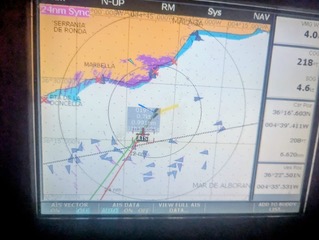Cassini blog#162 Cassini back in sea-going mode...

Cassini's blog
Simon and Sally, Nigel and Catherine
Tue 6 May 2025 19:57
6th May 2025 Cassini back in sea-going mode It was agreed that the first leg should be from Marseille to Gibraltar and that we would do this in one hop. That is just under 700 miles following the coast of France and Spain before landing in Gibraltar. We needed more crew to do this successfully and a general appeal saw our old ARC+ friend Mark and our Eastbound trans-Atlantic friend Liz step up to the plate. With myself, Mark and Liz doing one-in-three watches, that left Simon to support as required, and Catherine to help out as and when needed. It makes for a good routine and ensures everybody gets enough sleep and stays fresh. As usual, catering for such a trip takes some effort and we made full use of the large supermarket in Marseille and managed to pre-cook four full meals to make life easier when at sea. This proved to be more than adequate after the first day when not many people fancied a big meal! All the little extras we bought in Marseille were also very welcome. On returning to Marseille from our winter base we topped up all our extra fuel cans just in case we needed them. With the onboard tank and 160 litres on the side in jerry cans, we have enough fuel to motor over 500 miles, but we will still need some sail power to get us to Gibraltar. As it happened we used about 180 litres of fuel to fill the windless gaps. We topped up again in Gibraltar which is significantly cheaper than elsewhere in the Mediterranean as it is tax free. The plus side of running the engine is that you get hot water which was a welcome boost to morale. As usual the weather plays an important part in all we do. There is a local wind called the Meltemi which comes down from the Pyrenees and blows across the Gulf of Lyon. It can be quite feisty and regularly achieves gale force. As we were due to leave Marseille, a Meltemi was in the offing. The day we wanted to sail it was forecasting 20-25 knots. We would not normally venture into that by choice, but we calculated that we could get ahead of it in the first 24 hours, after which it would ease off considerably and we would miss the worst. This did prove to be the case, but it didn’t help the crew who had not been to sea for six months to find their sea legs! Thankfully we all battled through and came out the other side intact. Another factor was that even in late April and early May in the Mediterranean, we still needed full foul weather gear for a lot of the passage. We also topped up with water in Marseille and ran the water maker daily on passage. We tend to use about 60 litres of water per day and the water maker can make 60 litres of water per hour, so running it for an hour per day keeps us fully tanked up. One thing that did surprise me on this trip was the number of large merchant vessels just loitering East of the Gibraltar Straits. The night before our arrival in Gibraltar we were greeted by dozens of merchant ships just drifting, and frankly getting in the way. We were running downwind and this created quite a problem as even with a worked-up crew it can take 10-15 minutes to gybe (change course) with our twin head sails and main sail. I am not sure of the Rule of the Road in this situation. They are underway but not making way, but they are only restricted in their ability to manoeuvre by choice. Who gives way to who? The reality is we had to divert around them before our final run into Gibraltar. I tend to plan on making 5 knots on passage which means 120 miles per day. As it happens, we averaged 138 miles over the 5 days and got to Gibraltar in plenty of time for Mark to catch his plane home and Liz to wander further into Spain. Our next leg from Gibraltar to the UK will be somewhat different as we have plenty of time and we are looking forward to spending more days in some of the places we really want to visit. More of that later. Nigel the Navigator.  The plotter onboard showing some 35 vessels drifting in the Straits of Gibraltar.  |
![]() smime.p7s
smime.p7s
Description: S/MIME cryptographic signature